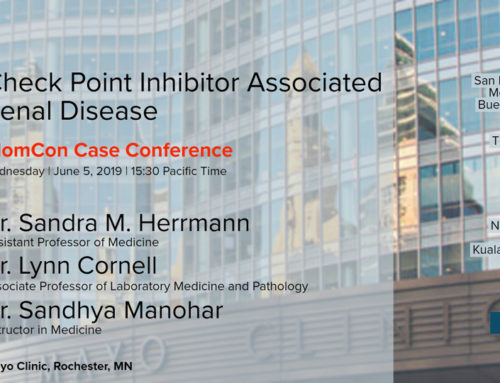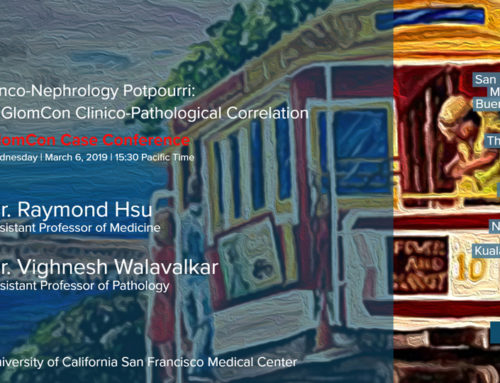ONCO-NEPHROLOGY
Renal Effects of Novel Anti-Cancer Drugs
A GlomCon conference led by Dr. Jhaveri for the presentation. Our Moderator’s Notes are derived from his live presentation.


By Dr. Jessica Lapasia
Nephrologist
The Permanente Medical Group
Key points:
- Targeted therapies act as ‘smart bombs’ and target specific molecular targets on tumor cells to block growth and spread of cancer. But these do have “off target” effects in other organs like the kidneys that share common receptors (e.g., VEGF in the podocytes, EGF-R inhibitors in the tubules), as well as through general immune dysregulation (e.g., checkpoint inhibitors triggering autoimmunity).
- Targeted therapies can cause a spectrum of renal disease including hypertension, proteinuria, ATN, TMA, electrolyte disorders, AIN, or immune-mediated glomerular disease.
- Direct VEGF inhibitors like bevacizumab and tyrosine kinase inhibitors like sunitinib can cause hypertension, proteinuria, TMA, AIN.
•With regards to a possible TMA, it is important to look for schistocytes, worsening hypertension (often the first sign of a TMA), and follow lab trends including platelets, Hgb, LDH, degree of proteinuria and renal function.
•While kidney biopsy might be challenging (e.g., thrombocytopenia), a tissue diagnosis can confirm/refute the need to stop a potentially life-saving therapy. Important to discuss with Oncologist regarding the biopsy plan and if alternative therapy could be considered.
•After stopping the drug, variable amount of time for TMA to resolve (can be months).
- Drugs like cetuximab and cisplatin can cause renal magnesium wasting. Diuretics (renal losses) and PPIs (GI losses) can potentiate this effect.
- Tyrosine kinase inhibitors (such as erlotinib, afatinib, gefitinib) are more likely to cause AKI and can also cause electrolyte abnormalities such as hypoK/hypophos/hypomag.
- BRAF inhibitors can cause rise in creatinine by decreasing tubular secretion of creatinine (not a true AKI) and/or by causing true ATN.
- Immune check point inhibitors like ipilimumab and nivolumab cause AIN (most commonly), but there are also reports of secondary membranous nephropathy, minimal change disease, and IgA nephropathy, as well as ATN and hyponatremia (by causing panhypopituitarism). Post-transplant patients who receive immune checkpoint inhibitors are at a higher risk for rejection and graft loss (often within weeks). Prophylactic steroids and conversion to rapamune before initiation of check point inhibitors may help reduce this risk.
- Fanconi syndrome in myeloma is typically associated with kappa light chains. However, lenalidomide can also cause Fanconi syndrome, DRESS syndrome/AIN, or minimal change disease. It can be helpful to look at the disease response (light chain trend) - if the disease is improving, AKI/Fanconi’s is more likely to be a drug than a light chain effect.
- Proteasome inhibitors, bortezomib, and carfilzomib, can cause TMA. Carfilzomib more commonly causes a pre-renal AKI.
- Venetoclax is a BCL-2 inhibitor and carries a higher risk of tumor lysis syndrome which occurs within hours of receiving the drug. TLS is associated with the first ramp-up in the dose of medication, and prophylactic measures should be considered.
- Axicabtagene ciloleucel, a chimeric antigen receptor T cell therapy (“CAR-T”) used in Non-Hodgkins lymphoma, can cause a cytokine release syndrome with capillary leak (mimics sepsis) and AKI in that setting.


